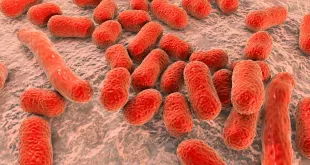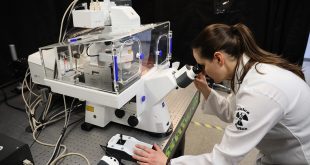By Jana Manolakos
Since its launch over a year ago, more than 200 scientists have joined the Canadian Black Scientist Network, banding together in an effort to make science, technology, engineering and mathematics (STEM) fields more equitable. It’s a small but mighty group, considering roughly 40,000 PhDs are awarded in Canada annually, and it falls far short of the 3.1 percent of Black people in a population of 38 million Canadians. Among these, Trevor Charles, Juliet Daniel, Lawrence Goodridge and Kiven Lukong, all network members and leading scientists, shared their experience and thoughts on Black representation in STEM.
Dr. Trevor C. Charles
Professor, Department of Biology
Director of Waterloo Centre for Microbial Research,
and founder of the biotech company Metagenom Bio Life Science Inc.
I am a microbiologist. Our research group works on bacterial genome engineering for the conversion of food waste to biodegradable bioplastics; microbial degradation of the herbicide glyphosate; the microbiome of hydroponic vegetable production systems; and surveillance of COVID variants in wastewater.
Representation is important. It ensures diverse perspectives and reinforces the link between science and the Black communities (we see how important this is during the pandemic). Black youth need to know that “scientist” is a potential career choice. Many Black families do not have any exposure to scientists, so the science career option is just not on the radar. There are also issues with streaming in schools.
Ultimately, we need to work on the entire pipeline, starting from the early years with exposure to science, and making connections by supporting organizations such as the Canadian Black Scientists Network.
ROLE MODEL:
Howard McCurdy was a microbiology professor at the University of Windsor, and federal MP.
Dr. Juliet Daniel
Cancer Biologist and Associate Dean of Research
and External Relations, Faculty of Science
McMaster University
My cancer biology research led me to discover and name a new gene, “Kaiso,” coined from my favourite Caribbean music, “calypso.” Kaiso regulates the expression of genes that control cell proliferation, cell adhesion and cell motility, biological processes whose malfunction all contribute to cancer or human developmental disorders. Consequently, Kaiso’s malfunction in cells leads to developmental disorders, and aggressive tumour growth and spread in various human cancers (e.g., breast, colon, prostate). My team is currently studying the aggressive and difficult-to-treat triple negative breast cancers that are most prevalent in young women of African ancestry and Hispanic women – groups that despite a lower incidence and lifetime risk of breast cancer than Caucasian women, have a higher mortality rate from breast cancer. My current research seeks to determine if Black women have a genetic predisposition or susceptibility to aggressive breast cancer. I partner with The Olive Branch of Hope cancer support service in Toronto to organize “Think Beyond ‘Love Pink’ Breast Cancer Awareness” workshops for women of African ancestry in Ontario and the Caribbean.
Black scientists are important to the Canadian STEM research ecosystem because of their diversity of lived experience, perspectives, research interests and global world views. Black scientists also enhance the diversity and type of STEM research questions pursued and studied, and they have different and diverse professional networks.
There are many possible explanations for the dearth of Black STEM scientists in Canada and “developed” countries in general. One obvious explanation is that many Black Canadian students do not see themselves reflected at the front of their elementary and high school classes, the lecture halls of university courses, or as positive role models in the media. This lack of Black academic and STEM representation has resulted in many gifted Black youth, with great potential to be scientists, thinking that they don’t have what it takes to excel as scientists and researchers.
Since there are so few Black STEM teachers, professors and scientists, this means there are also limited mentoring opportunities for our young aspiring Black scientists. Due to decades of systemic racism with many Canadian institutions and organizations, many Black youth and their families also face financial barriers to accessing post-secondary education and if they are first-generation university students, they seldom have anyone to guide them on their academic and professional journeys.
All educational institutions need to have more representation of Black teachers and professors. The media also needs to do a better job and showcase more Black academic achievements and our contributions to STEM research and inventions, nationally and globally.
ROLE MODEL:
I have always admired and been inspired by Dr. Mae Jemison, the first Black female astronaut in space in 1992. So, I was incredibly excited and awestruck when I met her in person in 1999 at the Minority EXCEL Conference, at McGill University in Montreal when we were both plenary speakers.
Dr. Lawrence Goodridge
Leung Family Professor in Food Safety
Director, Canadian Research Institute for Food Safety
University of Guelph
My current research relates to developing a new way to detect foodborne outbreaks faster than the current approaches. The new approach combines wastewater-based epidemiology, in which wastewater is analyzed for the presence of disease-causing microorganisms using genomic approaches, with social media syndromic surveillance, in which social media posts are analyzed to identify posts describing symptoms consistent with foodborne illness. The new surveillance method will be used by the Public Health Agency of Canada to detect foodborne illness earlier. My research is also directly relevant to the COVID-19 pandemic, as the same approaches are being used to detect outbreaks of COVID-19 in near real time.
Black scientists are important to the Canadian STEM research ecosystem for many reasons. The first reason is the fact that Black scientists can take advantage of their rich cultural history to bring a perspective to science that is seldom realized. For example, in my field of food science, there is a need to identify new natural antimicrobial compounds that can be used to control the presence of pathogenic bacteria in foods. A rich diversity of such compounds exists in plant species that are native to African and Caribbean countries where many Black STEM scientists have descended from. These plant species and their potential use remain largely unknown to the larger scientific community. Black scientists can use their knowledge to introduce this information to the community, enhancing scientific research.
Secondly, many Black people are treated every day for diseases and medical conditions based on the results of clinical trials that did not contain racially and ethnically diverse populations. The consequences of this include the fact that Black people may be exposed to serious unrecognized side effects and at a higher rate than white populations. Black scientists are keenly aware of such disparities and can conduct research aimed at developing knowledge regarding how medical treatments and drugs affect Black people specifically.
Finally, I have heard from many Black students regarding the lack of mentors who understand their unique struggles as they navigate higher education. Black STEM scientists can obviously fill this void.
One reason for the lack of Black STEM scientists in Canada is the lack of role models to emulate. We all grow up looking for mentors and role models that look like us, and in many cases, if a young person sees someone of the same gender or race in a profession, that can often be the impetus to decide on a career in that same profession.
Additionally, due to a lack of champions, Black students are often not exposed to the potential for careers in STEM fields. This last point is often magnified in high school, where Black students are often not encouraged, and even steered away from pursuing science degrees at university.
I would like to see the traditional grant review process overhauled to remove the bias that too often exists in Tri-council grant review panels, which too often leads to Black scientists not awarded grants, despite the high quality of scholarship. Additionally, though progress has been made with respect to increasing diversity within the Canada Research Chairs program, additional steps must be taken to ensure that the best and most deserving Black scientists are not overlooked for the program. Black scientists are often not exposed to, or do not come from, the top labs in Canada, which puts them at a disadvantage for prestigious awards. Therefore, mentorship and leadership programs should be established to help well-qualified Black scientists develop the qualifications and skills needed to compete successfully for national and international awards, and also to progress to positions of leadership at Canadian universities.
ROLE MODEL:
Dr. Ernest Melville DuPorte, a ground-breaking entomologist and parasitologist who played a key role in establishing the world-renowned Institute of Parasitology at McGill University’s Macdonald Campus in 1932, athough he has rarely been recognized for his accomplishments.
Dr. Kiven Erique Lukong
Professor, Biochemistry
PI: Signal transduction/Breast cancer
Department of Biochemistry, Microbiology & Immunology (BMI)
College of Medicine, University of Saskatchewan
The Lukong lab is a breast cancer research lab, with a focus on tyrosine kinases and their role in breast tumour formation and progression. Research in the lab is centered on breast tumours kinase (BRK) family Kinases (BFKs). The prototype member, BRK, is highly expressed in over 85 percent of breast tumours, but not in the normal mammary gland. The underlying cause behind this aberrant expression in breast cancers is unknown. The Lukong lab is investigating the cellular and physiological roles, and the mechanisms of action and modes of regulation of BEK in breast cancer, as well as the contribution of BRK in breast cancer drug resistance. Recent results from the Lukong lab indicate BRK as a viable therapeutic target in multiple-drug resistant-breast cancers.
First, all funding agencies must recognize that funding to Black researchers at all career levels is below representation. I know that a lot of effort is being done today to address equity, diversity and inclusion, but we are not yet there. Second, appoint Black scientists to top administrative positions or boards so that our voices can be heard and thus be visible role models.
The main goal is to increase the visibility of Blacks in STEM, identify role models and mentors and match them with mentees. There are fewer Black people in STEM than high positions in academia, private sectors or in the government. Young Black students start off strong and with a lot of enthusiasm in the undergraduate level, but start dropping out at the graduate levels because of the lack of role models in top positions. For example, I am the only Black professor in a department of about 30 faculty. There is a clear lack of representation of Blacks in STEM and other fields in all sectors. The Canadian Black Scientists Network is trying to change that.
ROLE MODEL:
I greatly admire the work that Dr. Juliet Daniel from McMaster University is doing. She is an experienced professor and skilled in molecular cell biology and cancer biology. Her research also focuses on the signaling roles of oncogenes in breast cancer. But above all, she is committed to improving equity, diversity and inclusion in higher education.
 BioLab Business Magazine Together, we reach farther into the Canadian Science community
BioLab Business Magazine Together, we reach farther into the Canadian Science community





